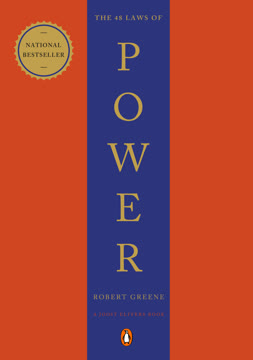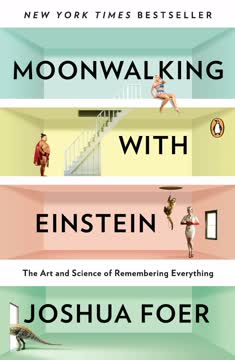Key Takeaways
1. Master the Three Keys of Memory: Association, Location, and Imagination
"Association is at the heart of developing a perfect memory. It is the mechanism by which memory works."
Association: The brain's natural tendency to connect ideas forms the foundation of memory techniques. By deliberately creating links between new information and existing knowledge, we can significantly enhance recall. For example, to remember that oxygen has the atomic number 8, picture a snowman (shape of 8) wearing an oxygen mask.
Location: Our three-dimensional world provides a natural framework for organizing memories. Using familiar places as mental "filing cabinets" allows for efficient storage and retrieval of information. This concept is the basis for powerful techniques like the Journey Method.
Imagination: The creative power of the mind serves as the fuel for memory. By forming vivid, unusual, or exaggerated mental images, we make information more memorable. The more outlandish the image, the more likely it is to stick in our minds.
2. Utilize the Journey Method for Effective Information Storage
"The Journey Method works by converting key words from each line into key images that can be linked together and then mentally 'placed' along each stage of the journey."
Create a mental route: Choose a familiar path, such as your home or a regular commute, with distinct stopping points. This becomes your mental journey.
Place information: Convert each piece of information you want to remember into a vivid image and place it at a specific point along your journey.
Review and recall: To retrieve the information, mentally walk through your journey, encountering each image in the order you placed them.
Benefits:
- Preserves the order of information
- Allows for easy addition or removal of items
- Can be reused for different sets of information
3. Develop a Personal Number-Shape System for Memorizing Digits
"We seem to be ever more surrounded by numbers and increasingly we are expected to memorize them in the form of PINs and codes for credit-card security or for accessing special accounts on the internet, or entry codes to offices."
Create visual associations: Assign shapes to numbers based on their appearance. For example:
- 0 = ball or hoop
- 1 = candle or pencil
- 2 = swan
- 3 = handcuffs
- 4 = sailboat
- 5 = hook
- 6 = elephant's trunk
- 7 = boomerang
- 8 = hourglass or snowman
- 9 = balloon on a string
Apply the system: To remember a PIN like 1580, imagine a pencil (1) writing on a hook (5), next to a snowman (8) bouncing a ball (0).
Practice and personalize: Adjust the system to fit your own associations and mental imagery for maximum effectiveness.
4. Apply the Dominic System to Remember Complex Numerical Data
"I do not have an innate talent for remembering numbers, but I do have a trained memory which allows me to memorize a sequence of up to 2,000 digits within one hour."
Assign letters to numbers: Use a consistent system to convert numbers to letters. For example:
- 0 = O, 1 = A, 2 = B, 3 = C, 4 = D, 5 = E, 6 = S, 7 = G, 8 = H, 9 = N
Create person-action pairs: Convert each pair of digits into a person's initials and an associated action. For instance, 43 becomes David Copperfield (DC) pulling a rabbit from a hat.
Combine with the Journey Method: Place these person-action pairs along a mental journey to remember long sequences of numbers.
Applications:
- Memorizing historical dates
- Recalling telephone numbers
- Remembering scientific constants
5. Enhance Name and Face Recall with Visualization Techniques
"Of all the concerns that people have shared with me about their memory, putting names to faces is number one on the list."
Focus on distinctive features: When meeting someone new, identify a unique facial characteristic or physical trait.
Create an associative image: Link the person's name to their distinctive feature using a vivid, often exaggerated mental image.
Place the image in context: Mentally situate the person in a location relevant to where you met them or where you might expect to find them.
Example: For "Margaret" who looks like a librarian:
- Visualize former British Prime Minister Margaret Thatcher
- Imagine her working at your local library
- Create a mental chain: Face → Library → Thatcher → Margaret
6. Boost Foreign Language Learning with Gender Zones
"Gender Zones provide two discrete geographical regions in your mind where everything is either masculine or feminine."
Choose two familiar areas: Select two distinct regions, one for masculine words and one for feminine words. For example, your home county for masculine and a neighboring county for feminine.
Create vivid associations: For each new vocabulary word:
- Determine its gender
- Place it in the appropriate zone
- Create a memorable image linking the word's sound or meaning to its location
Combine with other techniques: Use the Journey Method within each zone to organize vocabulary by topic or difficulty level.
Benefits:
- Simultaneous memorization of vocabulary and gender
- Easier recall of gender-specific grammar rules
- Scalable system for learning multiple languages
7. Employ Mind Mapping for Comprehensive Information Overview
"Mind Mapping offers a simplified diagrammatic overview of a subject and is an ideal way to present information in a visual form that your brain can easily grasp."
Start with a central concept: Place the main idea or topic in the center of your page.
Branch out key themes: Draw lines radiating from the center, each representing a major subtopic or category.
Add details and connections: Extend smaller branches from each main branch, adding relevant information, examples, and connections between ideas.
Use colors and images: Incorporate visual elements to enhance memorability and engage both hemispheres of the brain.
Applications:
- Note-taking during lectures or meetings
- Planning projects or presentations
- Summarizing complex texts or concepts
8. Memorize Speeches and Presentations Using Visual Cues
"One of the most effective ways to prepare a speech or presentation is to get all your ideas down onto a Mind Map, as described in the previous step."
Create a visual outline: Develop a Mind Map or Journey that represents the structure of your speech.
Assign key images to main points: For each major section or important detail, create a vivid mental image.
Practice visualization: Mentally walk through your visual outline, recalling the associated content for each image.
Benefits:
- Reduces reliance on written notes
- Allows for more natural, engaging delivery
- Improves ability to adapt to time constraints or audience reactions
9. Expand Memory Capacity with the Roman Room Method
"Using the same number of rooms, I am now going to show you how you can turn a 10-stage journey into one that can store five, 10, or even 50 times more items."
Select familiar rooms: Choose rooms or areas in your home or a well-known building.
Identify multiple anchor points: Within each room, select 5-10 distinct objects or features.
Create a consistent pattern: Establish a clockwise or counterclockwise order for mentally navigating each room.
Place information: Assign items to be remembered to each anchor point, creating vivid associations.
Example:
- Room 1 (Front Door): doorstep, mailbox, doorbell, door handle, doorframe
- Room 2 (Living Room): sofa, TV, bookshelf, window, fireplace
10. Master Advanced Techniques for Memorizing Cards and Binary Numbers
"In 2002 I memorized the order of 54 decks (2,808 cards) that had been shuffled into each other and dealt out just once. I made eight errors on the recall and this, at the time of writing this book, still stands as the current World Record for multiple-deck memorization."
Cards: Assign characters to each card
- Number cards: Use the Dominic System (e.g., Ace of Clubs = Al Capone)
- Face cards: Create unique characters (e.g., King of Hearts = Cary Grant)
Binary: Group digits and convert to base-10
- Group binary digits in threes (e.g., 101 = 5, 011 = 3)
- Combine two groups to form a two-digit number (e.g., 101011 = 53)
- Use the Dominic System to convert to a person-action pair
Combine with Journey Method: Place card characters or binary-derived images along an extended journey.
Practice strategies:
- Start with single deck or short binary sequences
- Gradually increase complexity and volume
- Time yourself to track improvement
11. Maintain Physical Fitness to Support Cognitive Function
"Our brains thrive on oxygen, and I believe the most productive way to help transport oxygen to the brain cells is through regular physical exercise."
Engage in regular aerobic exercise: Activities that raise your heart rate and breathing improve blood flow and oxygen delivery to the brain.
Incorporate strength training: Building muscle mass can contribute to overall health and cognitive function.
Practice mind-body exercises: Activities like yoga or tai chi combine physical movement with mental focus, potentially enhancing cognitive abilities.
Benefits of exercise for memory:
- Increased production of neurotransmitters
- Enhanced neuroplasticity
- Reduced risk of cognitive decline with age
- Improved focus and concentration during mental tasks
Last updated:
FAQ
What's "How to Develop a Brilliant Memory Week by Week" about?
- Memory Enhancement Focus: The book is a comprehensive guide to improving memory skills through a series of 52 steps, each designed to be tackled weekly.
- Structured Approach: It offers a structured approach to memory training, with each chapter focusing on different aspects of memory improvement, from basic tools to advanced techniques.
- Practical Exercises: The book includes practical exercises and tests to help readers apply the techniques and track their progress.
- Author's Expertise: Written by Dominic O'Brien, a world memory champion, the book draws on his extensive experience in memory training.
Why should I read "How to Develop a Brilliant Memory Week by Week"?
- Improve Memory Skills: The book provides proven methods to enhance memory, which can be beneficial in both personal and professional settings.
- Step-by-Step Guidance: It offers a clear, step-by-step guide that makes memory improvement accessible to everyone, regardless of their starting point.
- Practical Application: The exercises are designed to be practical and applicable to everyday situations, such as remembering names, numbers, and directions.
- Expert Insights: Gain insights from Dominic O'Brien, who has successfully trained his memory to world-class standards.
What are the key takeaways of "How to Develop a Brilliant Memory Week by Week"?
- Three Keys of Memory: The book emphasizes association, location, and imagination as the three fundamental keys to improving memory.
- Journey Method: A central technique taught is the Journey Method, which uses familiar locations to store and recall information.
- Dominic System: The book introduces the Dominic System, a method for memorizing numbers by associating them with people and actions.
- Regular Practice: Consistent practice and review are crucial for transferring information from short-term to long-term memory.
How does the Journey Method work in "How to Develop a Brilliant Memory Week by Week"?
- Familiar Locations: The Journey Method involves using familiar locations as a mental map to store information.
- Sequential Order: Information is placed along a predetermined route, preserving the order and making it easier to recall.
- Visualization: By visualizing vivid images at each stop, the method leverages the brain's natural ability to remember spatial and visual information.
- Reusability: The same journey can be reused for different sets of information, making it a versatile memory tool.
What is the Dominic System in "How to Develop a Brilliant Memory Week by Week"?
- Number-Person Association: The Dominic System converts two-digit numbers into initials, which are then associated with a person.
- Action and Prop: Each person is linked with a specific action or prop, creating a memorable image for each number.
- Complex Images: For longer sequences, the system combines characters and actions to form complex images.
- Efficient Memorization: This method allows for the quick and efficient memorization of large numbers by turning them into meaningful stories.
How can I use the techniques in "How to Develop a Brilliant Memory Week by Week" in daily life?
- Names and Faces: Use association and visualization to remember people's names by linking them to distinctive features or familiar places.
- Directions: Apply the Journey Method to memorize directions by visualizing each step along a familiar route.
- Numbers and Dates: Use the Dominic System to remember phone numbers, PINs, and important dates by converting them into characters and actions.
- Speeches and Presentations: Create a Mind Map or use the Journey Method to organize and recall key points during public speaking.
What are some practical exercises from "How to Develop a Brilliant Memory Week by Week"?
- Word Lists: Memorize lists of words using association and visualization techniques to improve recall.
- Number Sequences: Practice memorizing sequences of numbers using the Dominic System and Number Shapes.
- Shopping Lists: Use the Body System to remember shopping lists by associating items with parts of the body.
- Binary Numbers: Challenge yourself with binary number sequences using the Binary Code method for advanced memory training.
What are the best quotes from "How to Develop a Brilliant Memory Week by Week" and what do they mean?
- "Memory depends on three basic processes: making something memorable, storing that item in the mind, and recalling it accurately at some future time." This quote highlights the fundamental processes involved in memory and the importance of each step in effective recall.
- "Imagination is more important than knowledge. Knowledge is limited. Imagination encircles the world." Quoting Einstein, the book emphasizes the power of imagination in creating memorable associations.
- "You are never too young nor too old to acquire these skills." This encourages readers of all ages to engage in memory training, reinforcing the idea that memory improvement is accessible to everyone.
How does "How to Develop a Brilliant Memory Week by Week" address common memory challenges?
- Names and Faces: The book provides techniques for associating names with visual cues to overcome the common challenge of forgetting names.
- Complex Information: It offers methods like the Journey Method and Dominic System to handle complex information such as numbers and dates.
- Concentration: Tips for improving concentration are included, helping readers focus better and enhance memory retention.
- Stress Management: The book discusses the impact of stress on memory and offers strategies to manage stress for better cognitive performance.
How does "How to Develop a Brilliant Memory Week by Week" suggest improving concentration?
- Daily Practice: Engage in daily memory exercises to train your brain and improve focus over time.
- Relaxation Techniques: Use relaxation methods, such as visualization and meditation, to reduce stress and enhance concentration.
- Controlled Environment: Create a quiet, distraction-free environment for memory practice to maximize concentration.
- Physical Exercise: Incorporate regular physical activity to boost oxygen flow to the brain, supporting better concentration and memory.
What advanced techniques are covered in "How to Develop a Brilliant Memory Week by Week"?
- Roman Room Method: An extension of the Journey Method, using objects within a room as additional memory pegs.
- Complex Dominic System: Combines characters and actions for memorizing longer sequences of numbers and dates.
- Binary Code System: A method for memorizing binary numbers by converting them into base-10 numbers and using the Dominic System.
- Multiple Decks of Cards: Techniques for memorizing multiple decks of cards using the Journey Method and Complex Dominic System.
How does "How to Develop a Brilliant Memory Week by Week" incorporate health and lifestyle tips?
- Physical Exercise: Encourages regular physical activity to improve brain health and memory function.
- Balanced Diet: Recommends a diet rich in antioxidants and essential fatty acids to support cognitive performance.
- Stress Management: Offers strategies for managing stress, which can negatively impact memory.
- Holistic Approach: Emphasizes the importance of a healthy lifestyle in conjunction with memory training for optimal results.
Review Summary
How to Develop a Brilliant Memory Week by Week offers practical memory techniques and exercises, focusing on visualization, association, and location. Readers appreciate its structured approach and progressive difficulty. Many find the techniques effective, particularly for everyday tasks like remembering names and lists. Some reviewers note that while certain methods may seem outdated or impractical, the book provides valuable tools for memory improvement. The exercises are praised for allowing immediate practice and personalization. Overall, most readers find the book helpful in enhancing their memory skills, though some suggest it's best suited for beginners.
Similar Books









Download PDF
Download EPUB
.epub digital book format is ideal for reading ebooks on phones, tablets, and e-readers.







